Contents
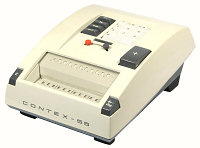
Contents |

|
| Contex Model 55, c.1970 |
![]() The firm of "Carlsen Brothers" from Gentoft in Denmark built two
interesting and innovative lines of mechanical calculators under the
"Contex" brand name. A simple half-keyboard adding machine was first
introduced in 1946, with a styling update in the early 1950s.
A range of ten-key non-printing calculators was introduced in 1957.
The Contex machines were produced in significant quantities,
and were exported to over 100 countries. The half-keyboard machines
were very popular in Australia during the 1950s and 60s.
The firm of "Carlsen Brothers" from Gentoft in Denmark built two
interesting and innovative lines of mechanical calculators under the
"Contex" brand name. A simple half-keyboard adding machine was first
introduced in 1946, with a styling update in the early 1950s.
A range of ten-key non-printing calculators was introduced in 1957.
The Contex machines were produced in significant quantities,
and were exported to over 100 countries. The half-keyboard machines
were very popular in Australia during the 1950s and 60s.
The first Contex line was a key-driven adding machine in the general style of the Comptometer, with an abbreviated ("half") keyboard and a greatly simplified internal mechanism. The machine was unusual in that most of the internal components were made from pressed fibreboard rather than sheet metal. In spite of their unorthodox construction, these machines were simple and reliable, and many are still found in good working order.
Contex half-keyboard adders were sold in both Sterling and decimal versions in Australia, generally dating from either side of the change to decimal currency in 1966. The Sterling models originally had keys for quarter-pence (farthings) and half-pence (ha'pennys), but these were deleted by the mid-1950s as ha'pennys fell out of general use. (Farthings were never issued as Australian currency).
The "Model A" designation refers to the machines in one-piece moulded bakelite cases which were manufactured from 1946. A re-styled Model B was introduced in the early 1950s, with a two-piece plastic case and a heavy metal baseplate. Model A machines are relatively rare in Australia now, as most of them were exchanged (at Government expense) for Model B decimal machines during the currency conversion in 1966.
Original advertising brochures claim that 10,000 Contex machines had been sold in Australia by the mid-1950s, 18,000 by the early 60s, and over 30,000 following the decimal currency conversion.
Click on the photos below for larger illustrations.
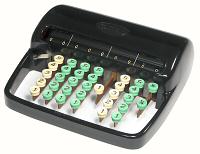 "Contex" Half-keyboard Adder, Model A, S/N 130161
"Contex" Half-keyboard Adder, Model A, S/N 130161
Digits: 8 keyboard, 9 accumulator
Sterling currency, with Farthings
Dimensions: 225W x 220D x 70H
Weight: 1.28kg
Manufactured: Denmark, 1946-50s
A Contex "Model A" calculator for Sterling currency, in a black moulded case. The keytops are colour-coded for Pounds (grouped by thousands), Shillings, and Pence.
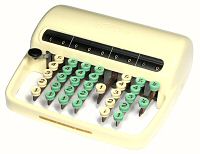 "Contex" Half-keyboard Adder, Model A, S/N 131698
"Contex" Half-keyboard Adder, Model A, S/N 131698
Digits: 8 keyboard, 9 accumulator
Sterling currency, with Farthings
Dimensions: 225W x 220D x 70H
Weight: 1.28kg
Manufactured: Denmark, 1946-50s
A Contex calculator for Sterling currency, in an unusual cream moulded case. The narrow label across the front of the machine is from the Australian distributors, Chartres Business Service (later Remington Rand Chartres).
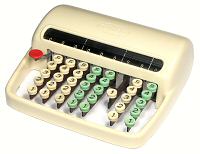 "Contex" Half-keyboard Adder, Model A, S/N 124773
"Contex" Half-keyboard Adder, Model A, S/N 124773
Digits: 8 keyboard, 9 accumulator
Sterling currency, without Farthings
Dimensions: 225W x 220D x 70H
Weight: 1.28kg
Manufactured: Denmark, 1946-50s
Another version of the Sterling-currency machine, with an additional Pounds column on the left replacing the Farthings column on the right. Note that the keytops in the right-hand Pounds columns are grouped by hundreds rather than thousands, so that they can also be used for decimal currency calculations in dollars and cents.
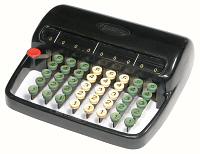 "Contex" Half-keyboard Adder, Model A, S/N 73053
"Contex" Half-keyboard Adder, Model A, S/N 73053
Digits: 8 keyboard, 9 accumulator
Decimal currency
Dimensions: 225W x 220D x 70H
Weight: 1.28kg
Manufactured: Denmark, 1946-50s
An early Contex decimal machine, with keytops colour-coded in groups of 3-3-2 to suit decimal currency calculations. The base is stamped with the serial number and "Patents Pending". (The first US patent for the Contex mechanism was filed in 1945 and issued in 1949).
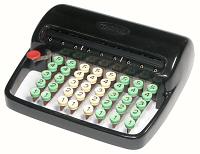 "Contex" Half-keyboard Adder, Model A, S/N 158589
"Contex" Half-keyboard Adder, Model A, S/N 158589
Digits: 8 keyboard, 9 accumulator
Decimal, grouped by thousands
Dimensions: 225W x 220D x 70H
Weight: 1.28kg
Manufactured: Denmark, 1946-50s
Another version of the Contex decimal machine with the keytops in the right-most columns grouped by thousands (2-3-3) rather than hundreds (3-3-2).
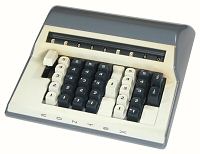 "Contex" Half-keyboard Adder, Model B, S/N 911428
"Contex" Half-keyboard Adder, Model B, S/N 911428
Digits: 8 keyboard, 9 accumulator
Sterling currency, with Farthings
Dimensions: 235W x 235D x 70H
Weight: 1.69kg
Price: £24-15-0 Australian
Manufactured: Denmark, 1950s-60s
The exterior design of the half-keyboard machine was updated with the introduction of the Model B in the early 1950s. The mechanism is basically identical to that of the earlier models, but the new styling makes a remarkable difference to its appearance.
The underside of this machine still carries the original price ticket from over 40 years ago.
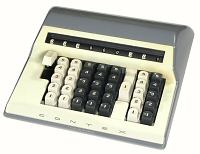 "Contex" Half-keyboard Adder, Model B, S/N 137386
"Contex" Half-keyboard Adder, Model B, S/N 137386
Digits: 8 keyboard, 9 accumulator
Sterling currency, without Farthings
Dimensions: 235W x 235D x 70H
Weight: 1.69kg
Manufactured: Denmark, 1950s-60s
This Sterling-currency Model B has replaced the farthings column on the right with an additional pounds column on the left. Otherwise, it is identical to the previous examples.
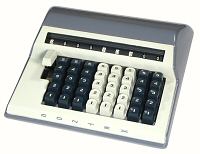 "Contex" Half-keyboard Adder, Model B, S/N 411 017 042
"Contex" Half-keyboard Adder, Model B, S/N 411 017 042
Digits: 8 keyboard, 9 accumulator
Decimal currency
Dimensions: 235W x 235D x 70H
Weight: 1.69kg
Manufactured: Denmark, 1950s-60s
Somewhere around 1960 the Contex serial numbers were changed to a 9-digit code, with the first three digits as a model number.
This late-model all-decimal machine has eight identical columns, with the keys and numerals colour-coded for decimal currency.
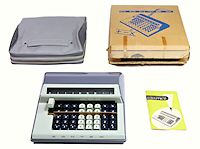 "Contex" Half-keyboard Adder, Model B, S/N 411 024 875
"Contex" Half-keyboard Adder, Model B, S/N 411 024 875
Digits: 8 keyboard, 9 accumulator
Decimal currency
Dimensions: 235W x 235D x 70H
Weight: 1.69kg
Manufactured: Denmark, 1950s-60s
This Contex B has never been used. It still has its original box and vinyl carry case, exactly as it came from the dealer in the mid-1960s. The box measures 250x250x80mm and weighs 2.1kg. Note the thick cardboard packing strip across the keyboard. The strip tucks under the edges of the case at each side and holds all the keys fully depressed, to stop them bouncing while the machine is in transit.
The elderly lady who provided this machine told me its story: "My husband bought it for our business back in the 1960s. I used to do the books, but I never used the machine. I just packed it away - I much preferred to use my brain".
The machine is still in perfect working order sixty years later, which seems to confirm the advice that the Contex fibre-board mechanism should not be lubricated.
The second Contex line was a series of four "ten-key" calculators in which the Comptometer-style keyboard was replaced by the now-familiar numeric keypad. These were quite ingenious machines which were directly capable of all four arithmetic functions. The different models were all built around the same basic mechanism, but varied in their levels of automation. Even the simplest manual Model 10 provided for semi-automatic division. Model 20 added an electric motor, Model 30 provided automatic multiplication, and Model 55 added fully-automatic division. A concise instruction sheet was provided on the underside of each machine.
The ten-key mechanism was predominantly of sheet-metal construction, but it also used a number of new synthetic materials in critical areas. Two of these materials (polyurethane and nylon) were the wonders of their age, but have since proven to be unstable in the long term. As a result, these attractive and ingenious machines are generally inoperable, and will eventually become un-repairable.
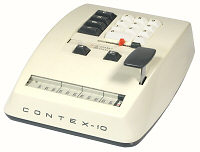 "Contex" Model 10, S/N 434 005 097
"Contex" Model 10, S/N 434 005 097
Functions: ASMD, manual operation, semi-automatic division
Digits: 10 keyboard, 11 accumulator, 1 counter
Dimensions: 200W x 255D x 100H
Weight: 2.67kg
Price: £42/0/0 Australian in 1965
Manufactured: Carlsen Bros, Denmark, 1957-
The manually-operated "Contex 10" from 1957 is the simplest machine in the ten-key range. The operating handle is a short-stroke plunger which falls naturally under the right hand after pressing the keys. The handle can be locked down when the machine is covered after use, or when it is to be stored in its carrying case.
The machine has only a single-digit counter register, visible in the shaded area on the right of the accumulator register. The counter is marked with two sets of complementary numbers, in black and red for multiplication and division. Multiplier digits are entered from the least significant (ie, right to left) in the usual fashion.
The process of division is semi-automatic, with the machine taking care of the underflow and correction. After setting up the dividend and divisor, the operator simply pumps the handle repeatedly until it locks. The red digit showing in the counter window is the first digit of the quotient. This is written down as soon as it is generated, the carriage is shifted to the right, and the process is repeated for as many digits as required.
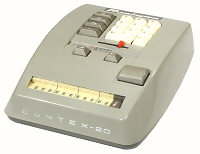 "Contex" Model 20, S/N 453 012 430
"Contex" Model 20, S/N 453 012 430
Functions: ASMD, electric operation, semi-automatic division
Digits: 10 keyboard, 11 accumulator, 1 counter
Dimensions: 200W x 255D x 100H
Weight: 3.17kg
Manufactured: Carlsen Bros, Denmark, 1961-
The Contex 20 from 1961 replaced the manual operating handle with a push-button controlling a small induction-motor drive. The machine is otherwise identical to the Model 10, although the example illustrated has an early brown-and-yellow colour scheme.
The "Remington" label visible above the keys was applied by the Australian distributors. Remington absorbed the original distributors (Chartres Business Systems) and went through several reincarnations, with machines variously labelled as Chartres, Remington, Remington Rand or Remington Rand Chartres. By the time the Contex 55 arrived in 1968 it was the Remington division of Sperry Rand.
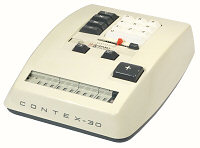 "Contex" Model 30, S/N 473 022 492
"Contex" Model 30, S/N 473 022 492
Functions: ASMD, electric, automatic multiplication, semi-automatic division
Digits: 10 keyboard, 11 accumulator, 1 counter
Dimensions: 200W x 255D x 100H
Weight: 3.21kg
Price: £98/10/0 Australian
Manufactured: Carlsen Bros, Denmark, 1965-
The Contex 30 from 1965 extended the functions of the Model 20 by providing automatic multiplication, implemented through an ingenious cycle counting mechanism built into the numeric keypad.
Once the first number (the multiplicand) has been entered, the operator presses the "X" key to change the keypad into cycle-counting mode. When the first (ie, least significant) digit of the multiplier is pressed, the machine will perform the required number of addition cycles and shift the pin carriage one place to the left. The process is repeated as subsequent digits are entered. The keypad returns to its normal function when the machine is cleared.
The counter register continues to operate during multiplication, but the mechanism does not provide a means for clearing it between digits. Hence the black digit on the counter register is meaningless, so it is simply masked from view by the cutout in the register escutcheon.
 "Contex" Model 55, S/N 493 011 463
"Contex" Model 55, S/N 493 011 463
Functions: ASMD, electric, automatic multiplication and division
Digits: 10 keyboard, 11 accumulator, 10 quotient
Dimensions: 205W x 290D x 120H
Weight: 4.30kg
Manufactured: Carlsen Bros, Denmark, 1968-1970s.
The Contex 55 extended the functions of the Model 30 by fully automating the division process and providing a full 10-digit quotient register. A "Division Stop" key was added so that the operator could halt the process after the required number of digits.
The quotient register is a simple but ingenious mechanism which counts the subtraction cycles in each digit position. It is mounted as an "add-on" above the existing accumulator register. The single-digit counter register is no longer required for either multiplication or division, and so has been deleted.
Although the new quotient register only raises the height of the mechanism by half an inch, the revised styling makes the machine look much larger than the other models in the series.
A firm in Sydney provided custom-built carry cases to suit the
Contex A and B calculators. The timber cases were covered with
leatherette (a type of coated cloth, with an embossed leather-grain
pattern), and were lined with baize or felt - green for the Model A,
red for the Model B. The machine could be used without removing it
from the case, or the lid could be removed completely via the
detachable hinges. The case cost £2-15-0 in the 1950s, or just
over 10% of the cost of the machine.
Case illustration from Contex brochure
Case maker's label
The timber cases were "modernised" in the late 1950s to suit the new ten-key machines.
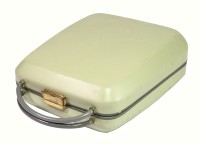 Original Contex 10-key Carrying Case
Original Contex 10-key Carrying Case
This is an original "Made in Denmark" moulded plastic case to suit the three smaller ten-key machines. It is rare to find original manufacturers' cases in Australia. Until the 1970s many local industries (and especially the furniture trades) were protected by heavy import tarrifs, which made items such as carrying cases prohibitively expensive. As a result, local purchasers were denied the matching cases for their stylish new Contex machines and had to make do with the rather ordinary timber cases above.
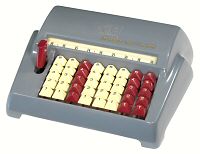 Speedee "Add-a-Matic" Half-Keyboard Adder
Speedee "Add-a-Matic" Half-Keyboard Adder
Digits: 8 keyboard, 9 accumulator, decimal
Dimensions: 280W x 225D x 85H
Weight: 1.40kg
Manufactured: Japan, 1972
The Speedee "Add-a-Matic" is a Japanese version of the Danish "Contex" machines (above). Although there is a British-looking coat of arms with the inscription "CM Inc, Chadwick" moulded into the top of the case, the base is clearly stamped "Made in Japan - Patent Pend". The fine print on the original box indicates that the machine was manufactured in Japan for Chadwick Miller Inc of Boston. The original owner has dated this machine "24/4/72".
The mechanism of the "Add-a-Matic" is identical to the "Contex" in
design, although cheapened somewhat in materials and construction. A
similar machine with a different housing but the same internal
mechanism was sold by Commodore Business Machines, who later achieved
fame in computers with the Commodore PET, VIC-20, and Commodore 64.